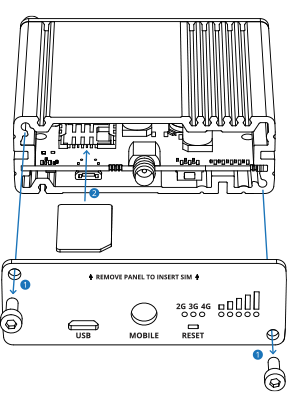TRB140 SIM Card: Difference between revisions
(Created page with "{{Template: Networking_device_manual_sim_card | name = TRB140 | series = TRB14x }}") |
No edit summary |
||
| (One intermediate revision by the same user not shown) | |||
| Line 1: | Line 1: | ||
{{Template: Networking_device_manual_sim_card | {{Template: Networking_device_manual_sim_card | ||
| name | | name = TRB140 | ||
| | | file_sim = Networking_trb140_manual_sim_card.png | ||
<!--------------STEPS--------------> | |||
| 1 = Unscrew the two back panel hex bolts and remove the back panel. | |||
| 2 = Insert your SIM card into the SIM socket. | |||
}} | }} | ||
Latest revision as of 09:36, 23 June 2020
Main Page > TRB Gateways > TRB140 > TRB140 Manual > TRB140 SIM CardThis chapter provides a description on how to correctly insert a SIM card into a TRB140 device.
|
|
||||||||
The device is compatible with mini-SIM (2FF) size cards. But since different types of SIM cards have the same contact arrangement, smaller SIM cards can also be used with the router, provided they are inserted into a 2FF SIM card adapter. A size perspective of the most popular SIM card types can be seen in the figure below:
Micro-SIM (3FF) cards can be used with a 3FF to 2FF SIM card adapter such as this one:
Nano-SIM (4FF) cards can be used with a 4FF to 2FF SIM card adapter such as this one:
The measurements of the different SIM card types are as follows:
| SIM card format | Length (mm) | Width (mm) | Thickness (mm) |
|---|---|---|---|
| Mini-SIM (2FF) | 25.00 | 15.00 | 0.76 |
| Micro-SIM (3FF) | 15.00 | 12.00 | 0.76 |
| Nano-SIM (4FF) | 12.30 | 8.80 | 0.67 |




